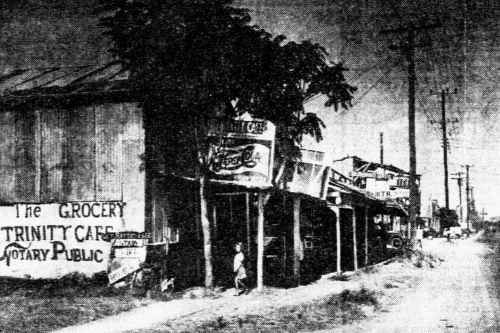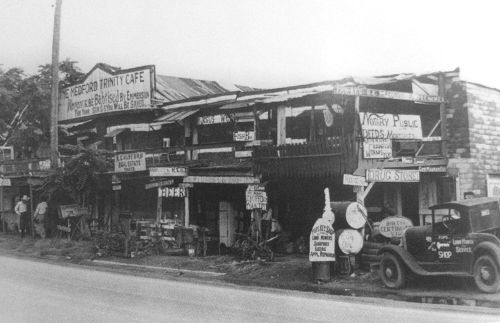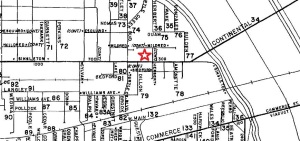The Eccentric Medford Compound On the Old Eagle Ford Road: 1945-1950
by Paula Bosse
by Paula Bosse
Above, 409-413 Singleton Blvd. in West Dallas, not long after the name of the street had been changed from Eagle Ford Road. The name-change happened in 1942 because of “unfavorable incidents in the past which had been associated with Eagle Ford Road” (The Dallas Morning News, April 26, 1942) — “Singleton” was Vernon Singleton, a former Oak Cliff County Commissioner. Today, this area is part of the super-hipstery Trinity Groves neighborhood; the block seen in the photo is now mostly occupied by a parking lot and looks like this.
Back then, “Eagle Ford Road” would have conjured up all sorts of unsavory images of bad behavior and illegal activities, and, even now, one tends to think immediately of the area’s most notorious exports: Bonnie and Clyde. Immediately after World War II, the population of West Dallas (an area which would not become part of the City of Dallas until its annexation in December 1952) was about 12,000, and its residents were generally poor and living in substandard housing with inadequate water and drainage and little in the way of sanitary facilities.
The “complex” above — which consisted of, basically, the Trinity Cafe, a grocery/drug/dry-goods store, and a residence — was perhaps a bit more colorful than most of the businesses that lined Eagle Road/Singleton Blvd. in post-war West Dallas. The property was owned by Richard Elbert Medford (1864-1950), who, as one of the signs says, was also known as “The Rev. R. E. Medford, Preacher” (I’m not sure if he was an actual ordained minister or just a self-styled preacher). In 1944 or 1945 — after several years of selling mattresses — Medford took over the collection of rickety buildings seen in the photo above and began to sell a wide-ranging collection of unrelated stuff and painted a lot of signs. He remained in business there until his death in 1950 at the age of 86 (the cause of death was “senile exhaustion” which I gather means “died of old age”).
The signage in the photo is … well … it’s fantastic. It’s verging on Outsider Art. Medford offered everything, including (but not limited to):
- Real estate
- Beer
- Notary Public services (deeds, mortgages, birth certificates…)
- Keys
- Appliance repair
- Lawn mowers
- Oil
- Fish bait (minnows, crawfish, worms, and “flys”)
He also offered religious advice (“Repent & Be Babtised By Emmersion For Your Sins You Will Be Saved”).
Mr. Medford’s personal life was not a happy one, and perhaps the unrelenting family dramas caused him to become more and more eccentric as the years went by. Many of his children found themselves caught up in the crime and violence West Dallas had become known for.
- One teenage son was shot and wounded during an attempted robbery in 1930, two months before one of his daughters married at the age of 13.
- Another son, who was 11 years old, was killed when he attempted to intervene in a fight between his sister and her husband and was fatally kicked in the abdomen by his brother-in-law.
- Another son was a habitual criminal who committed an eye-popping range of crimes and was in and out of city, county, state, and federal correctional facilities throughout his life. (This son, Homer, was also married for a short time to the ex-wife of Clyde Barrow’s brother L. C. Barrow, but that marriage hit the skids when she shot Homer, sending him to the hospital with critical — but not fatal — wounds.)
- And in 1951, after Rev. Medford’s death, the son who had been shot in 1930 while attempting to break into a store in Irving, shot and killed his wife and young son before killing himself.
So, yeah, Rev. Medford’s life was a rough one, and there were definitely some dark days in hardscrabble West Dallas. I’d like to think his store, plastered with its kooky signs, offered him some respite from the incessant melodramas percolating all around him.
 Singleton Blvd., late 1940s, not yet part of Dallas
Singleton Blvd., late 1940s, not yet part of Dallas
*
The location of the Medford house/cafe/store, seen on a 1952 Mapsco (click for larger image).
***
Sources & Notes
I came across the photo years ago on the Dallas History Facebook group. There was no source, but there appears to be a copy of this photograph in the Jim Doster Collection at the Dallas Pubic Library titled “Meford [sic] Trinity Cafe on Singleton Blvd.,” incorrectly dated as 1930 (call number PA97-7/147). I’m sure a higher resolution image of this would offer up quite a few amusing details and discoveries.
*
Copyright © 2018 Paula Bosse. All Rights Reserved.



This is fantastic, Paula. Thank you.
LikeLiked by 1 person
Thanks, Randall!
LikeLike
This is so fun to see! My grandfather Rev. Alexander Franklin Whitmire lived on the same street, had a store, a garage and was a preacher too! I have a similar photograph of his establishment during the same time period. I’m guessing they were neighbors and competitors.
LikeLiked by 1 person
I’d love to see your photo, Julie. If you wouldn’t mind sharing, you can send it to my email address, which you can find above at the “About/Contact” tab. Thanks!
LikeLike
(2nd try) My name is Pauline Marceleno Laws, Board Member, Dallas Mexican American Historical League. I was so glad to find this article… we had found the Medford picture and put it in our West Dallas collection. We last exhibited at the Latino Cultural Center and will exhibit at the State Fair in September.
I would love to have a picture of July Whitmire’s grandfather’s store for our La Bajada section of the collection. Contact me anytime. Pauline Laws
LikeLiked by 1 person
If I come across anything I’ll certainly let you know!
LikeLike
So sorry to just now be getting back with you- I read this and then got tied up with work and life!
I would be so happy for you to have this for the collection.
Is this image good enough or do you need a scan or print?
LikeLike
Hello Julie, I read all this again today, love that history! Would you please contact me at email lawssmith@sbcglobal.net. I’d like to know if you have any old pictures of that area known now as La Bajada, and Trinity Groves. I still collect photos and history for the Dallas Mexican American Historical League (DMAHL). I’d love to hear from you. I reside in Oak Cliff on the southern side of Kiest Park in Dallas. p
LikeLike
[…] “THE ECCENTRIC MEDFORD COMPOUND ON THE OLD EAGLE FORD ROAD: 1945-1950” […]
LikeLike
The mystery of how bonnie Barker and Clyde Barrow first met maybe a mystery the rumor of Bonnie Parker met Clyde Barrow on January 5, 1930, at the home of Clyde’s friend Clarence Clay at 105 Herbert ST West Dallas (aka EagleFord /Cement City Tx) but if you look at some info you get a answer.Bonnie Parker Mother Emma Parker moved her children to her parents home 2908 Eagle Ford Road (now Singleton Blvd) . Then Clyde Barrow family Henry/Cummie Barrow gas station /home back at 1620 Eagle Ford Road (now Singleton Blvd). Bonnie and Clyde went to school at Eagle Ford School -nearby -Chalk Hill Road interstate 30. They both in the area -grew up in the area & probarbly went to the same places in the area ? Clyde 1909 -Bonnie1910 only 1 year apart? They same elementary school/playground as kids as well & went to Same Parks .
LikeLike
Thirty years ago, I spent a week helping a friend whose elderly mother had Alzheimer’s. She grew up in and around West Dallas and attended school with Bonnie Parker. She would continue with her stories growing up, repeating them several times. She told me Bonnie met Clyde when he was fifteen, and they would hold hands after school. Something happened, and Clyde quit coming to school. She continued to tell me that Clyde had been sexually abused by his aunt and was afraid of girls and that Bonnie and Clyde never had sex and barely kissed.
I cannot confirm her story, but she swore that Clyde was a virgin until the night before Bonnie and Clyde were assassinated.
LikeLiked by 1 person
[…] The Eccentric Medford Compound On the Old Eagle Ford Road: 1945-1950: A surprisingly popular old post which has recently had a huge number of hits after the Netflix movie “The Highwaymen” began showing — I guess people were googling “Eagle Ford,” B&C’s old stomping grounds. […]
LikeLike
Hello, in reviewing this history today it looks like we never got the picture of Julie (not July!) Whitmire’s grandfather’s store on Eagle Ford Road (now Singleton Blvd.). I’d still love to have a copy if Julie ever found the photo. Thanks a bunch! Pauline Marceleno Laws. 10-28-22.
LikeLiked by 1 person
That was my Great Great Great Grandfathers store. The stories surrounding him and his children were pretty interesting and were talked about in hushed tones when the “old people” of the family got together to reminisce. When his daughter left to marry my Great x2 grandfather they basically just left the Medford family behind. Unfortunately my mother, who was the “keeper of the stories”, passed away almost 3yrs ago and took most of those stories with her.
LikeLiked by 1 person
My family moved to this neighborhood in 1965 on 3320 Brantley St( you can see the letters TLEY on the map close to NOMAS). The Medford area has been replaced with a barbar shop, Hensly’s Auto Store and various Mom and Pop stores while living in the area from 1965 thru 1987. These stores have also been replaced due to progress.The neighborhood and area was known as La Bajada and now called Trinity Groves. Believe it or not. I experienced a great childhood living in the area despite it’s notoriety. I still have friends living in the neighborhood and am aware of the struggles to keeping their homes due to higher property taxes and the whole renovations taking place in the neighborhood and going West on Singleton. Talk about progress! Rev. Medford would not recognize the old neighborhood. I don’t recognize the old neighborhood.
LikeLiked by 1 person
Thanks for your comment, Joanna!
LikeLike